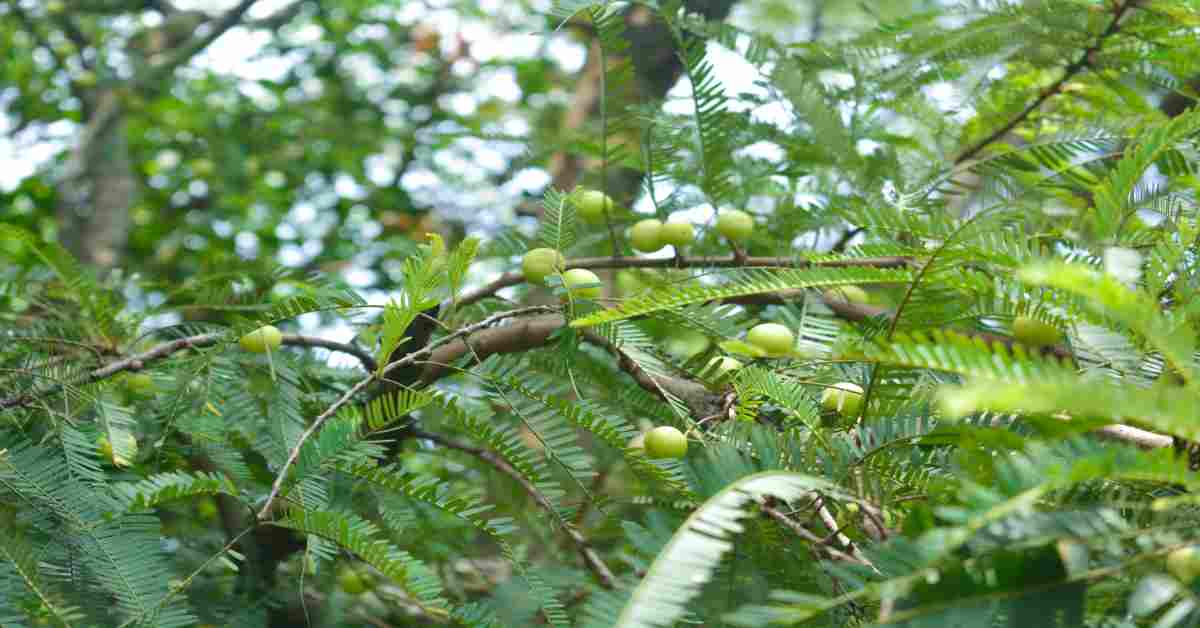Indian mythology holds that gooseberry, a member of the Euphorbiaceae family and also known as Phyllanthus emblica or Amla and was the first tree created in the universe. As per Ayurveda, Gooseberry benefits includes cancer, ulcers, anemia, heart diseases, liver diseases, diabetes, and many more. Together with these additional functions, it has antioxidant, antitussive, gastroprotective, immunomodulatory, analgesic, and antipyretic properties.
About Indian Gooseberry
- Indian Gooseberry (Emblica officinalis) (EO) holds a revered place in Ayurveda, an ancient kind of medicine used in India.
- It is indigenous to India, although it also grows in Pakistan, Uzbekistan, Sri Lanka, South East Asia, China, and Malaysia in tropical and subtropical climates.
- The gooseberry tree is small to a medium-sized deciduous tree that typically grows to a height of 8 to 18 meters. Its thin, light-grey bark exfoliates in tiny, uneven flakes, revealing the younger, lighter-colored surface beneath the older bark.
- It is one of the finest sources of vitamin C, amino acids, and minerals and is very nutrient-dense. It has many different chemical components, including tannins, alkaloids, and phenols. Emblicanin A and B, among all hydrolyzable tannins; gallic acid; and ellagic acid show biological action. Almost all parts have therapeutic benefits, notably the fruit, which is utilized in Ayurveda as a potent rasayana. In traditional medicine to treat diarrhea, jaundice, inflammation, and a variety of other diseases.
- Gooseberry benefits in Indian medicine, either alone or in conjunction with other plants, to cure common colds and fevers, as a diuretic, laxative, liver tonic, refrigerant, stomachic, restorative, antipyretic, hair tonic, and to prevent ulcers and dyspepsia. The analgesic, antitussive, anti-atherogenic, adaptogenic, cardio, gastro, nephro, neuro-protecting, and anticancer effects of amla in pharmacological study studies. Moreover, it is helpful in ocular problems to improve cognition and manage cholesterol levels. Also useful as an antibacterial and for neutralizing snake venom.
- It also hold further anti-mutagenic, anti-inflammatory, free radical scavenging, radio, chemopreventive, immunomodulatory, and antioxidant properties. These qualities are effective in the treatment and prevention of a wide range of illnesses, including anemia, liver, heart, and cancer as well as atherosclerosis, diabetes, peptic ulcers, aneurysms, and other conditions.
Chemical composition
- Gooseberry is one of the most researched plants. According to some reports, it includes tannins, alkaloids, and phenols. Fruits contain 28% of the total tannins found in the plant as a whole.
- The fruit contains two hydrolyzable tannins, Emblicanin A and B. Both have antioxidant characteristics. One produces gallic acid, ellagic acid, and glucose upon hydrolysis. While the other produces ellagic acid and glucose.
- Phyllemblin is also present in the amla fruit that shows the amla benefits. Many phytochemicals are discovered using activity-guided fractionation, including gallic acid, corilagin, furosin, and geraniin.
- Flavonoids such as quercetin and alkaloids such as phyllantine and phyllantidine are also present.
- It also comprises amino acids and sugar. Its fruit juice has the greatest vitamin-C concentration. Vitamin C levels are higher than in oranges, tangerines, and lemons.
Health Benefits of Gooseberry
- Antioxidant activity: Gooseberry is high in vitamin C and low molecular weight hydrolyzable tannins, making it an excellent antioxidant. The tannins in gooseberry, such as emblicanin-A (37%), emblicanin-B (33%), punigluconin, and pedunculagin, are commonly known to protect against oxygen radicals. Ellagic acid, a potent antioxidant found in Amla, can suppress gene mutations and repair chromosomal defects.
- Anticancer activity: Breast, uterus, pancreatic, stomach, and liver cancers are only a few of the malignancies that amla stops from growing and spreading. It can mitigate or prevent the negative effects of radiation and chemotherapy. There are over 18 different chemicals commonly found in gooseberry fruit that have anti-proliferative effects on uterine and stomach cancer cells. It works primarily by boosting the activity of Natural Killer (NK) cells in different tumor cells. gooseberry fruit’s emblicanin A and B have potent antioxidant and anticancer capabilities.
- Respiratory disorders: Breathing disorder It is already proven that gooseberry can restore regular breathing even when the system is under stress. To make the paste, 9 seeds of Black pepper, and one clove with 25 milliliters of ghee. The best treatment for asthma, cough, and other respiratory conditions is fresh amla juice with honey.
- Migraine: Women are more likely than men to experience migraine and severe vascular headaches. Using a paste composed of dried Amla powder, kumkum, Neel kamal, and rose water will treat this.
- Antidiabetic activity: Amla fruit powder improves blood pressure management. Amla, Harada, and Bahera are the three plants that makeup Triphala. To normalize this enzyme take one teaspoonful of this combination, which comprises equal parts powdered amla, jamun, and bitter gourd. Chromium, a mineral found in Amla fruits, is what gives them their anti-diabetic properties.
Other Benefits of Gooseberry
- Prevents indigestion: Amla powder benefits includes proper digestion. Constipation is irregular and infrequent bowel movements. Use 1 teaspoon of amla powder with milk or water every morning to treat this condition.
- Jaundice: Soak 4 munakkas for 1 hour with fresh amla fruits, and then mix with amla juice. This proportion might improve jaundice.
- Piles: After lunch, consume 100 grams of milk, 100 grams of fresh amla juice, half a teaspoon of ghee, and one teaspoon of honey to treat chronic piles.
- Improve eyesight: Triphala powder (made by combining Harada, baheda, and Amla powder) with honey is an eye tonic that maintains the vision bright and brilliant. It is also beneficial to the digestive system.
- Effect on skin: Because of its strong astringent properties, which eliminate impurities and thoroughly cleanse and purify the skin. Amla is good for all skin types, particularly aged skin and skin that is dull or devitalized. It is an excellent skin regenerator and aids in the battle against aging.
- Effect on hair growth: It is a great hair regenerator since it stimulates the hair follicles and stimulates the roots. It also helps to slow your fall (except in cases of congenital alopecia). Its antioxidant properties aid in the prevention of premature greying. It also has a conditioning effect on the hair, giving it softness and gloss, enhancing texture, and preventing split ends.
- Weight loss management: Many researchers have indicated that gooseberry has excellent fat-burning effects. This plant boosts metabolism while also increasing protein synthesis and decreasing fat accumulation.
- Anti-inflammatory activity: Amla is useful for treating hay fever, arthritis, osteoporosis, and joint discomfort, according to many studies.




